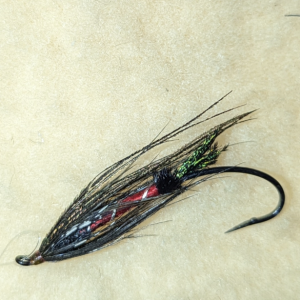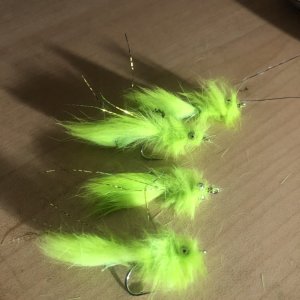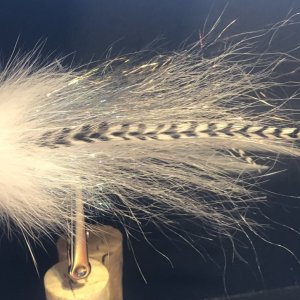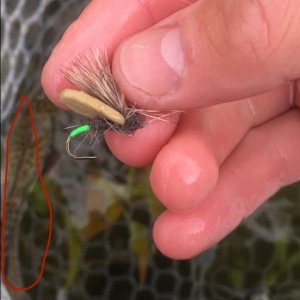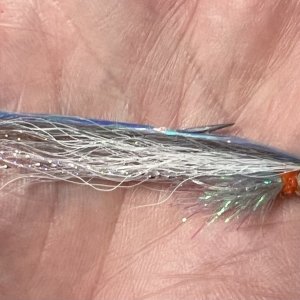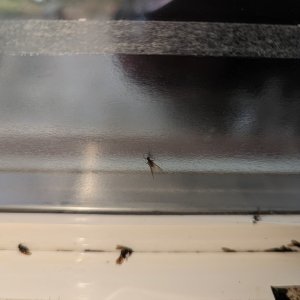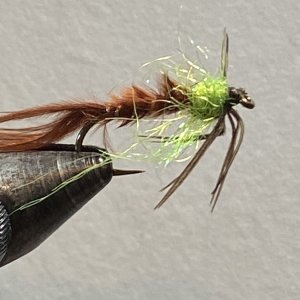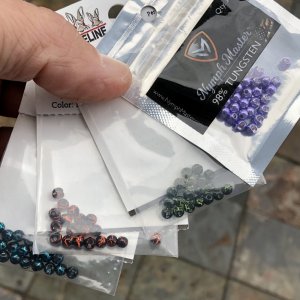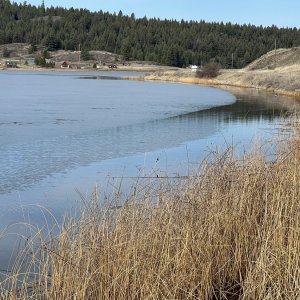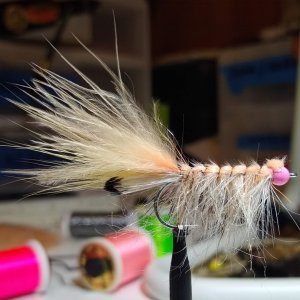Does anyone use multi-d sink tips with your skagit heads? I bought a guideline 4d scandi head, and the tips are about the same length and weight as a T-8/10 sink tip. They don't have the oomph to throw rabbit leeches, but they actually work pretty well with smaller/lighter flies on a skagit head. I like the H/I and 1/3 tips for fishing the top couple of feet and not hitting bottom in slower water, but I've also got a 3/5 tip that sinks really fast. When would a multi-d Sink tip that sinks at 6/7 ips at the end be better than just 10 feet of T-11?
You are using an out of date browser. It may not display this or other websites correctly.
You should upgrade or use an alternative browser.
You should upgrade or use an alternative browser.
Sink tip choice? Multi-d vs T-stuff.
- Thread starter DerekWhipple
- Start date
Yeah, I use them occasionally, but day in day out, I just have never seen a real benefit. I'm throwing a short intermediate Skagit on my SH with ~7.5' of t11 and that has served me perfectly on small-medium sized coastal rivers. I never noticed a change in catch rate either way going with a variety of 8' 3d tips from SA.
I get the idea and usefulness of a 3D line, but not for tips. I mean, we're talking about a tip that's only 8' or 10' long and is connected on one end to a floating or intermediate head. It is already being forced to be 3D. One end starts where the head ends and the other will be as deep as the head will allow it. Just another way for these line companies to make some extra $$.
I really like the MOW & OPST tips. I mean, if you have 2.5, 5, 7.5 and 10' in the appropriate T weight I can't imagine needing anything else. Tips are already too expensive.
I really like the MOW & OPST tips. I mean, if you have 2.5, 5, 7.5 and 10' in the appropriate T weight I can't imagine needing anything else. Tips are already too expensive.
I get the idea and usefulness of a 3D line, but not for tips. I mean, we're talking about a tip that's only 8' or 10' long and is connected on one end to a floating or intermediate head. It is already being forced to be 3D. One end starts where the head ends and the other will be as deep as the head will allow it. Just another way for these line companies to make some extra $$.
Yeah, I notice that, seeing the tip drag down your head a little bit. Does 2 feet of intermediate really make a difference?
I should probably check out the OPST tips, I see that they have slower sink rates. The reason why I started experimenting with scandi head tips I had was sometimes T-8 or 11 hits bottom too soon in slower or shallow water, but I do want to keep the fly down.
fatbillybob
Steelhead
I wonder if the better one can control his line the more multi-density offers the user? I still fish like a caveman with a club, so skagit head and T tips or scandi line and poly leaders are how I fish. They seem to work.
G_Smolt
Legend
I like multi-density heads for a couple situations.
I like integrated intermediate/Tmaterial tips of various sizes and sink lengths for fast, shallow water with large flies, the kind you need line mass to turn over but without the "dig" of a full 11' of, say, t14.
I also like fishing integrated float/Tmaterial heads (also of various sizes/lengths) with unweighted (but again, large) flies in boulder gardens - the short sink section allows for a small, convex (in relation to the surface) "bow" that you can steer around the rocks easier.
I like integrated intermediate/Tmaterial tips of various sizes and sink lengths for fast, shallow water with large flies, the kind you need line mass to turn over but without the "dig" of a full 11' of, say, t14.
I also like fishing integrated float/Tmaterial heads (also of various sizes/lengths) with unweighted (but again, large) flies in boulder gardens - the short sink section allows for a small, convex (in relation to the surface) "bow" that you can steer around the rocks easier.
fatbillybob
Steelhead
I hate the T stuff with a passion. I hate how it casts and I hate how it fishes.
15 foot 150 grain type 6 or a floating line is all you need.
Lots will disagree but oh well. I just don't think what sink tip you are using matters that much.
I like your simplistic idea. I think if you can manage line you can manage line. I think that's what it is all about.
Isn't a type6 level line 150G @ 15ft. just what might be called T10 in T language? How does that cast or fish differently than 15ft of T8 or T11? What you are fishing sounds like the Rio 15ft. replacement tips. I have heard others swear by the replacement tips while swearing at T tips. I never understood why? Maybe that 3ft. front taper makes a big difference but your type 6 is straight like a T tip right?
Rob Allen
Life of the Party
I like your simplistic idea. I think if you can manage line you can manage line. I think that's what it is all about.
Isn't a type6 level line 150G @ 15ft. just what might be called T10 in T language? How does that cast or fish differently than 15ft of T8 or T11? What you are fishing sounds like the Rio 15ft. replacement tips. I have heard others swear by the replacement tips while swearing at T tips. I never understood why? Maybe that 3ft. front taper makes a big difference but your type 6 is straight like a T tip right?
Like you say, I am simplistic. I didn't even know or care that there was any taper to the Rio tips..
I can tell you this. When I started using t material I stopped catching fish.. I think I was always fishing too deep.. I think a long leader and a weighted fly and a floating line is better than t materials.
This might be helpful as sort of a baseline. This is straight from Rio (Farbank) website describing the Skagit MOW tips. First the descriptions:
The Extra Heavy MOW Tips are the heaviest of the MOW series; built with T-17 for the sinking section and with a sink rate of nearly 10" per second, it really gets down when depth is needed. Each of the tips either have a gray floating section, or if full sinking are a dark gray color, for easy identification. These tips are ideal on the heavier Skagit lines of 675 grains and more.
The Heavy MOW Tips feature T-14, with a sink rate of 9" per second, for the sinking material. Each of these tips has either a light blue floating section, or if full sinking are a dark blue color, for easy identification. The Heavy MOW Tips are designed for the large flies and are ideal for Skagit lines of 575 grains and more. There are six unique tips that make up the series.
The Medium MOW Tips feature T-11, with a sink rate of 8" per second, for the sinking material. Each of these tips has either a light green floating section, or if full sinking are a dark green color, for easy identification. The Medium MOW Tips are designed for heavily weighted flies and are ideal for Skagit lines between 475 and 575 grains. There are six unique tips that make up the series.
The Light MOW Tips feature T-8, with a sink rate of 7" per second, for the sinking material. Each of these tips has either a white floating section, or if full sinking are a dark red color, for easy identification. The Light MOW Tips are designed for lightly weighted flies and are ideal for Skagit lines of 475 grains and less. There are six unique tips that make up the series.
And here is their chart. Unfortunately, they don't add the advised grain weight, like in the description, to the chart. Also don't list the actual grain weight of the tip itself. Seems silly they don't, but maybe they thought it would be less confusing that way. Who knows.
I just know that if your spey or switch rod likes a 475gr weight Skagit line you should use a T-11 or T-8 head for best casting results. And if the 12.5' T-11 is not getting deep enough then try a heavier fly or feed line or something other than just jumping right to a 12.5' T-14 and having a terrible time casting it. Or worse, broken rods from hitting it with a heavy fly. On the beach we call that getting "Clousered". Not good.
Same with a 575gr rod. Use T-11 or T-14. Don't use T-17 and expect great results. It might work for the fishing you want to do, but it's gotta work for casting first.
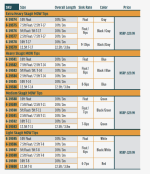
The Extra Heavy MOW Tips are the heaviest of the MOW series; built with T-17 for the sinking section and with a sink rate of nearly 10" per second, it really gets down when depth is needed. Each of the tips either have a gray floating section, or if full sinking are a dark gray color, for easy identification. These tips are ideal on the heavier Skagit lines of 675 grains and more.
The Heavy MOW Tips feature T-14, with a sink rate of 9" per second, for the sinking material. Each of these tips has either a light blue floating section, or if full sinking are a dark blue color, for easy identification. The Heavy MOW Tips are designed for the large flies and are ideal for Skagit lines of 575 grains and more. There are six unique tips that make up the series.
The Medium MOW Tips feature T-11, with a sink rate of 8" per second, for the sinking material. Each of these tips has either a light green floating section, or if full sinking are a dark green color, for easy identification. The Medium MOW Tips are designed for heavily weighted flies and are ideal for Skagit lines between 475 and 575 grains. There are six unique tips that make up the series.
The Light MOW Tips feature T-8, with a sink rate of 7" per second, for the sinking material. Each of these tips has either a white floating section, or if full sinking are a dark red color, for easy identification. The Light MOW Tips are designed for lightly weighted flies and are ideal for Skagit lines of 475 grains and less. There are six unique tips that make up the series.
And here is their chart. Unfortunately, they don't add the advised grain weight, like in the description, to the chart. Also don't list the actual grain weight of the tip itself. Seems silly they don't, but maybe they thought it would be less confusing that way. Who knows.
I just know that if your spey or switch rod likes a 475gr weight Skagit line you should use a T-11 or T-8 head for best casting results. And if the 12.5' T-11 is not getting deep enough then try a heavier fly or feed line or something other than just jumping right to a 12.5' T-14 and having a terrible time casting it. Or worse, broken rods from hitting it with a heavy fly. On the beach we call that getting "Clousered". Not good.
Same with a 575gr rod. Use T-11 or T-14. Don't use T-17 and expect great results. It might work for the fishing you want to do, but it's gotta work for casting first.

The first skagit setup I bought had the OPST tips that were labelled things like riffle/run/bucket. IIRC, they were MD sink rates like 2/3, 5/6 etc. I think they were flat not tapered. OPST claims that the slight variation in sink rate helps create a 'straighter sink' compared to level sink tips. You can read all about it here: https://www.gorgeflyshop.com/store/...L9DCJSIF5aYy9G7-FdNh4QPseyq8s62xoCwncQAvD_BwE
I can't say one way or the other if these MD tips make any difference compared to their flat sink rate counterparts. I was new at the time and had nothing to compare against. I also mostly got away from fishing a switch rods and skagits in favor of spey rods and scandis/short and mid bellies. The RIO short belly with replaceable tips is a formidable winter line as is the guideline 4d scandi.
I can't say one way or the other if these MD tips make any difference compared to their flat sink rate counterparts. I was new at the time and had nothing to compare against. I also mostly got away from fishing a switch rods and skagits in favor of spey rods and scandis/short and mid bellies. The RIO short belly with replaceable tips is a formidable winter line as is the guideline 4d scandi.

